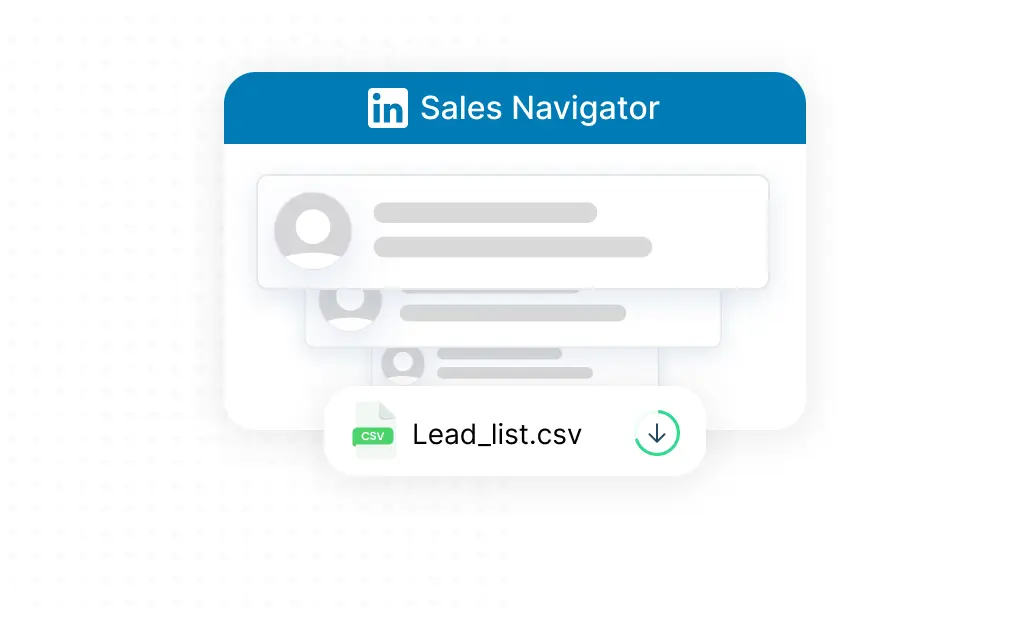





Start with key metrics, analyze data, and summarize insights for your sales report.
By the way, we're Bardeen, we build a free AI Agent for doing repetitive tasks.
Since you're learning about sales reports, consider our AI for sales. It automates tasks like data collection, letting you focus on insights and strategy.
Crafting a stellar monthly sales report is a critical skill for any sales manager or business owner. A well-written report not only keeps stakeholders informed but also helps identify trends, spot issues, and make data-driven decisions. Did you know that companies using sales analytics are 5x more likely to make faster decisions?
In this step-by-step guide, we'll walk you through the key elements of a winning sales report and share tips on how to gather, analyze, and visualize your data. Plus, we'll introduce you to AI-powered tools like Bardeen that can automate repetitive reporting tasks and save you hours each month. Get ready to level up your sales reporting game!
A well-crafted monthly sales report should provide a comprehensive overview of your sales performance, including key metrics, comparisons, and insights. Here are the essential components to include:
KPIs are critical metrics that help you gauge the health and performance of your sales efforts. Some common sales KPIs to include in your monthly report are:
By tracking these KPIs over time, you can identify trends, set benchmarks, and make data-driven decisions to optimize your sales strategy. Explore automation in sales prospecting to enhance data gathering for these metrics.
To provide context and measure growth or decline, include comparisons of key metrics to previous periods, such as the prior month or the same month last year. This allows you to spot patterns and assess whether your sales are improving or declining.
For example, compare total revenue, number of new customers acquired, and average deal size to the previous period. Visualize this data with charts or graphs to make it easy to understand at a glance.
While the data tells the "what", it's important to also include written analysis that explains the "why" behind the numbers. This is where you can provide context, highlight key factors that influenced the results, and share insights or learnings.
For instance, if sales were lower than expected, note any challenges faced like supply chain issues or market shifts. If you exceeded targets, explain the strategies or tactics that contributed to that success, so they can be replicated. These insights can be supported by understanding sales intelligence for strategic planning.
Begin your monthly sales report with a brief executive summary that highlights the key takeaways for busy leaders who may not have time to dig into the full report. This should be a concise overview of the most important points, such as:
Keep the executive summary to a paragraph or a few bullet points at most, focusing on the crucial information decision-makers need to know.
In summary, a robust monthly sales report incorporates sales KPIs, period-over-period comparisons, written analysis, and an executive summary to provide a thorough yet digestible view of sales performance to drive better decision-making.
To write an effective monthly sales report, you first need to gather and analyze the right data. A CRM system, documented sales process, data hygiene, and collaboration with finance are key to collecting accurate, insightful sales data.
A CRM (customer relationship management) system is a powerful tool for gathering sales data for your monthly report. It tracks all your sales activities and customer interactions in one centralized place.
With a CRM, you can easily pull key metrics like number of leads, conversion rates, deal sizes, and revenue generated. It saves time versus manual data gathering and ensures you have a comprehensive view of sales performance.
Having a clearly defined sales process is crucial for knowing what data to track and analyze. Document each stage of your process, from initial outreach to closed deal.
For example, your process might include steps like prospecting, initial call, demo, proposal, and closing. Define what success looks like at each stage and track those metrics. This could be number of calls made, demos given, proposals sent, and deals won. To enhance your process, learn about sales demo best practices to improve conversion rates.
Want to make prospecting more efficient? Discover how to automate sales prospecting with Bardeen and save time while focusing on closing more deals.
For your sales data to be useful, it must be accurate. Implement data hygiene best practices to keep your CRM data clean and reliable.
This includes regularly deduping records, standardizing data entry, and focusing analysis on the most relevant products, regions, or customer segments. Accurate data is essential for drawing the right conclusions and making informed decisions.
Your sales data should align with the revenue numbers reported by finance. Collaborate with the finance team to reconcile any discrepancies between the deal amounts in your CRM and their booking records.
A strong sales and finance partnership ensures you have "one source of truth" for revenue data in your monthly report. It builds trust and credibility in the numbers.
By leveraging your CRM, following a clear sales process, maintaining data hygiene, and partnering with finance, you'll have a solid foundation of data for your monthly sales report. You can then focus on uncovering insights to improve sales performance.
Next, we'll dive into how to visualize your sales data with charts and graphs to bring your monthly report to life. Stay tuned to learn tips for creating compelling visuals that communicate key insights at a glance.
Charts and graphs are essential tools for presenting sales data in a monthly report. They make the data more engaging, easier to interpret, and help highlight key trends and insights. Choosing the right type of graph and formatting it effectively is crucial for communicating your message clearly.
While raw numbers in a table can be informative, they don't capture attention as effectively as visual representations. Graphs and charts bring your data to life, making it more memorable and impactful.
For example, instead of listing out monthly revenue figures, visualize the data in a line graph that shows the upward or downward trend over time. This instantly communicates whether sales are improving or declining.
Different types of graphs are better suited for presenting different types of sales data. Here are some common examples:
Once you've selected the appropriate graph type, it's important to format it in a way that enhances clarity and readability. Some best practices include:
You don't need to be a design expert to create compelling graphs for your sales report. There are many user-friendly tools available, such as:
Many of these tools offer pre-built templates and customization options to help you create professional-looking charts with minimal effort.
Effective data visualization is a key element of a persuasive monthly sales report. By presenting your sales data in a visually appealing way, you'll better engage your audience and drive your key points home.
Next up, we'll explore how to take your monthly sales report to the next level by adding insightful analysis and actionable recommendations. Get ready to impress your boss and team with a report that not only shares the numbers but also provides strategic guidance.
A monthly sales report should go beyond just presenting data by including written insights and analysis. This context helps readers understand the story behind the numbers - the "why" and "how" rather than just the "what". Insights turn raw data into actionable information.
For example, say your sales data shows a 15% increase in revenue compared to last month. The insight might explain that the jump was driven by a wildly successful email campaign that brought in a flood of new customers. Providing that context makes the data meaningful.
Don't assume the data speaks for itself. While the sales metrics quantify performance, your written analysis explains if the results are good, bad, or neutral and why.
Consider two scenarios: Revenue is flat to last month or revenue is up 25%. Without commentary, the reader doesn't know how to interpret those results. Is flat revenue actually a win because it reverses a declining trend? Is 25% growth disappointing because it's lower than expected? Always provide context.
Analyze what factors had the greatest positive or negative impact on sales results. Look for root causes behind the data. Some common drivers:
For example, your analysis might reveal that revenue growth was largely attributable to the strong launch of a new product, but was partially offset by an aggressive competitor discount.
The best insights don't just explain the data, they recommend what to do about it. Your monthly sales report should include specific actions to address challenges and opportunities uncovered by the data.
For instance, if the data shows that sales growth is coming from a few large deals rather than an increase in average deal size, the action might be to implement a sales training program focused on upselling to grow deal sizes across the board.
Bardeen automation can save you time by automating repetitive tasks. Automate repetitive tasks and focus on insights that drive action.
How you communicate your insights is just as important as the substance. Write in a clear, concise, and professional tone:
Well-written insights enhance the credibility and impact of your sales report.
Thorough analysis is what elevates a monthly sales report from a mere data dump to an essential decision-making tool. Combine clear insights with compelling data visualizations to deliver a report that drives action and results.
Thanks for sticking with us! As a reward for reading this far, here's a sales joke: Why did the sales chart go to the doctor? It had a low bar! With the tips in this guide, your sales reports will be anything but subpar.
Mastering the art of crafting an impactful monthly sales report is crucial for driving better business decisions. This step-by-step guide covered:
By following this blueprint, you'll deliver a concise monthly sales report that influences strategy. Don't wing it or your performance may suffer! Use automation in sales prospecting for better efficiency.










SOC 2 Type II, GDPR and CASA Tier 2 and 3 certified — so you can automate with confidence at any scale.
Bardeen is an automation and workflow platform designed to help GTM teams eliminate manual tasks and streamline processes. It connects and integrates with your favorite tools, enabling you to automate repetitive workflows, manage data across systems, and enhance collaboration.
Bardeen acts as a bridge to enhance and automate workflows. It can reduce your reliance on tools focused on data entry and CRM updating, lead generation and outreach, reporting and analytics, and communication and follow-ups.
Bardeen is ideal for GTM teams across various roles including Sales (SDRs, AEs), Customer Success (CSMs), Revenue Operations, Sales Engineering, and Sales Leadership.
Bardeen integrates broadly with CRMs, communication platforms, lead generation tools, project and task management tools, and customer success tools. These integrations connect workflows and ensure data flows smoothly across systems.
Bardeen supports a wide variety of use cases across different teams, such as:
Sales: Automating lead discovery, enrichment and outreach sequences. Tracking account activity and nurturing target accounts.
Customer Success: Preparing for customer meetings, analyzing engagement metrics, and managing renewals.
Revenue Operations: Monitoring lead status, ensuring data accuracy, and generating detailed activity summaries.
Sales Leadership: Creating competitive analysis reports, monitoring pipeline health, and generating daily/weekly team performance summaries.